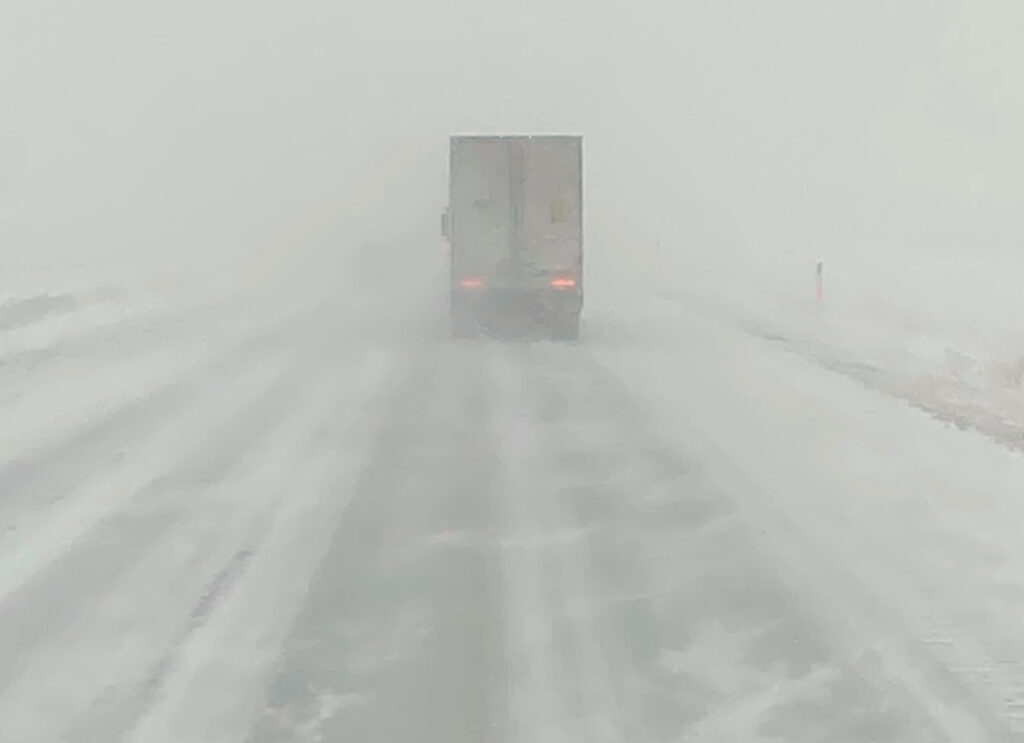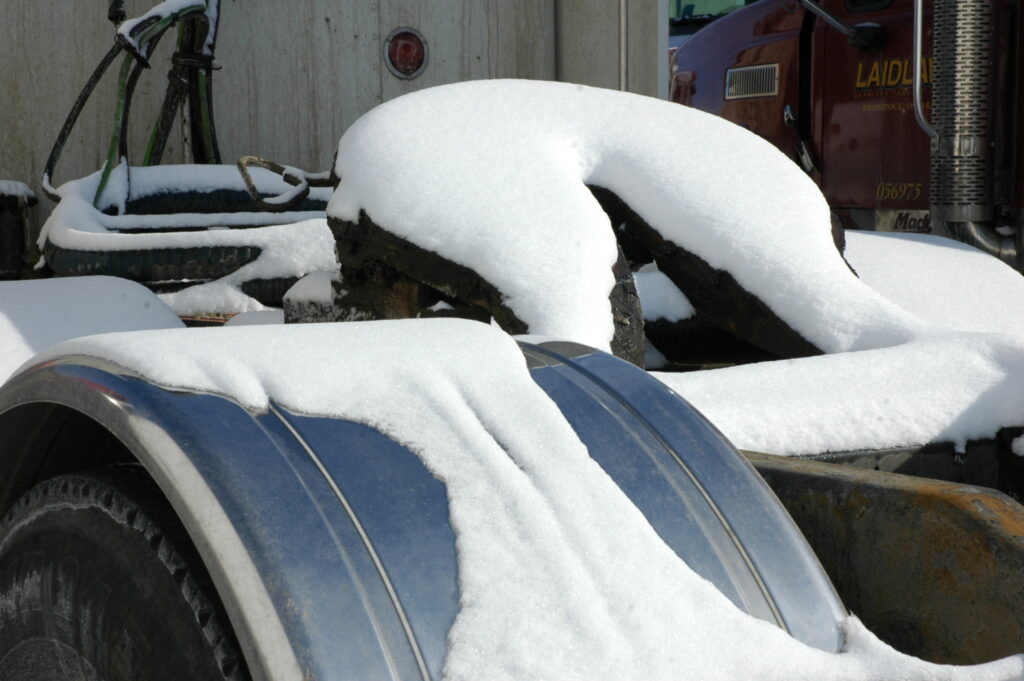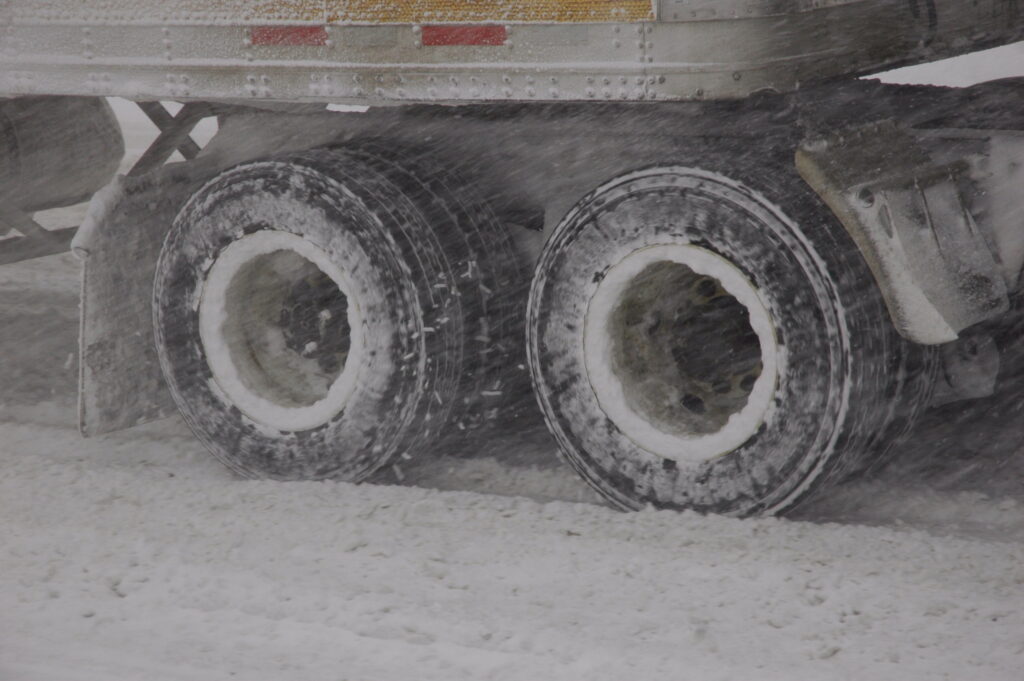The finer points of winter driving: Driver’s Education
The biggest mistake most drivers make when driving in snow is following too closely. If the roads are slippery — largely a given in snowy conditions — brake traction is vastly reduced. A hard brake resulting from an attempted panic stop will more likely lead to a jackknife than a significant reduction in speed. Either way, a rear-end collision or jackknife will bring your day to an unhappy end unless you leave enough time to react to a developing situation.
I said “most drivers”, and I believe that to be true.

Even experienced drivers tend to drive too fast for conditions when the weather is poor. Seasoned drivers tend to be complacent about the risks, while rookie drivers, seeing what the experienced drivers are doing, try keeping up but are more or less ignorant of the danger.
There are no tricks or tips for driving in snowy conditions except to stay back, increase your safety margin, and stay alert for other drivers getting into trouble. This is an issue even at low speeds in stop-and-go traffic. Roads are slippery and trucks have greater momentum that cars. Cars can stop faster than trucks.
That said, here are a few things worth knowing about ice and pavement conditions.

Beware of un-melted ice
Ice can be a factor even on sunny days when pavement appears dry. The sun doesn’t shine under freeway underpasses, and if there’s frost on the road from the previous night, it may linger under bridges as ice. This normally isn’t a big concern on straight sections of road, but icy curves can make for exciting moments. Be doubly cautions about braking in a curve under an underpass. My rule of thumb is to take my foot off the throttle and coast through any questionable conditions.
The same applies for any sections of roadway that are in shadow, like when you’re driving through the mountains or around tall buildings. If the sun doesn’t shine on the pavement, icy sections can lurk anywhere.
On mild days, it’s common to see snowbanks melting and the water flowing across the road. After dark, when temperatures drop, that water can freeze. Don’t assume the dark sections that were puddles earlier in the day are still liquid. Be careful braking or steering through curves on potentially icy surfaces.
“Somewhere north of Dayton, the temperature dropped a few degrees and the road had become a water-covered skating rink.”
Bridge decks are also more susceptible to icing than surrounding roads built on solid ground. The ground retains some geothermal heat, which can help prevent icing. Bridge decks don’t retain the heat as effectively, so they may freeze faster or remain icy after other roads have thawed. Avoid hard braking and be careful steering on bridges when temperatures are close to or below freezing.
Even rain can be tricky in the fall, winter, and spring. It may fall as water, but it can freeze on a cold surface, causing extremely slippery conditions.
I recall a late fall evening many years ago, driving north on I-75 between Dayton and Toledo, Ohio. Rain had been falling for several hours and we were all getting pretty comfortable with the crappy weather, but in the space of about mile somewhere north of Dayton, the temperature dropped a few degrees and the road had become a water-covered skating rink.
I met the ice on a curve in the highway. Vehicles ahead of me were suddenly unable to negotiate the curve and began running straight off the road into the median. I happened to be in the left lane, so I moved further left and got up high on the berm and onto some gravel where there was traction. I managed to stop before hitting anything, but my trailer was still on the paved portion of the road, and still on ice.
Because we were in a curve, the road banked higher to the left. I’ll never forget the long moments after I had stopped as I watched the trailer wheels slide down the slope in the road ever closer to an auto carrier that had stopped beside me. The trailer stopped sliding just inches before it hit the other fellow. Many others weren’t so lucky. We all had just seconds to react to the change in conditions.

Signs of icing
Keep an eye on your mirrors for accumulating ice. You may not see it forming on the windshield if you have the defroster on and the glass is relatively warm. You may also notice ice beginning to form on the windshield wipers because they aren’t warmed by the defroster.
Another sign is the absence of road spray from the tires. On wet roads, you’ll see tire spray. If the roads are icy, but look wet, you won’t see any spray. If you’re driving on what appears to be wet pavement, but you see no tire spray, you’re probably driving on ice.
Many new trucks display ice warnings, alerting drivers to possible icy conditions. These usually appear when the temperature gets to three or four degrees above the freezing point. Ice isn’t imminent, but it’s possible, so drive accordingly, especially in wet conditions.
In snowy conditions, the tire tracks in the lanes can become covered with hard-packed snow, which can be as slippery as ice. If you’re driving on such a surface, slow down, open up your following distance, and avoid hard braking and dramatic steering.
Because surface conditions can change and degrade with little notice, drivers should avoid using cruise control and engine brakes in questionable conditions. Any external forces acting on the drive wheels, such as acceleration or deceleration from engine braking, can cause the wheel to break traction on slippery surfaces.
Even though modern cruise controls systems are designed to disengage immediately upon sensing a loss of traction, under some conditions a skid may have already begun before the system can react. That, of course, can lead to a jackknife.
If you sense the truck beginning to skid, the absolute best course of action is to release the brakes and let the wheels return to a free-rolling state. The truck will straighten itself if the skid hasn’t progressed too far.
Since you are probably applying the brakes for a reason, releasing them might seem like a bad idea. That’s why leaving adequate stopping distance is so important. If you leave yourself enough room to react, you won’t have to apply the brakes hard to begin with. You will also leave yourself a bit of time to try steering around the obstacle, even if it means steering for the ditch. You’re better off in the weeds than crushing a Toyota Prius.

A few words on traction
Tires have a lot to do with maintaining traction, but so does weight and engine torque. If you are lightly loaded, your wheels are more likely to break traction than when heavily loaded. Think about it. An empty tractor-trailer weighs about 30,000 pounds (14,000 kg), so each wheel end on a five-axle combination will be supporting about 3,000 pounds (1,400 kg). In reality, there’s a little more on the steer axle and a little less on the trailer.
It doesn’t take much of a brake application on a slippery surface to lock up a lightly loaded wheel. It gets a bit tricky when you have freight in the front of the trailer but nothing in the back. The lightly loaded trailer axles will lock up more easily than the loaded drive axles. You must brake gently when loaded like that on slippery roads.
One of the trickiest scenarios involves pulling up a hill on snowy roads. The high levels of engine torque used to pull up long steep hills can easily cause the drive wheels to break traction, sending them sliding down the pavement crown and into the ditch. Once one driver breaks traction on a hill, that usually blocks the highway.
Shifting gears during an uphill climb is risky, too, because of the surge in torque when the throttle pedal is pressed down after the gear change. If you’re moving on a hill, albeit slowly, be grateful and avoid upshifting to gain a bit of speed. That mistake could cost you a few hours waiting to be towed out of the ditch – not to mention the angry wrath of the drivers behind you.
Ironically, one of the easiest places to become stuck in the winter is a parking lot covered in hard-packed snow. When parking after a long stretch of driving, the “warm” tires can melt into the hard-packed snow. They might melt only an inch or so, but that inch is a like a wheel chock times 18 or more wheels. Don’t set the brakes and bail out right away. Let the truck sit five or 10 minutes and roll it backward or forward a few times so the tires don’t have a chance to melt into the snow before they cool down.
Have your say
This is a moderated forum. Comments will no longer be published unless they are accompanied by a first and last name and a verifiable email address. (Today's Trucking will not publish or share the email address.) Profane language and content deemed to be libelous, racist, or threatening in nature will not be published under any circumstances.
I have seen y load of ice on the roads plus white out like in the Yellow Stone park this is scary even if you are not driving fast you can not see anything and not to panic just have a quick look at your GPS and id the road seem to go straight just do it it did work for me so driving in the mountains my favorite sport to pump the adrenalin is do not think to far ahead and slow down and analyze the current condition and keep a good momentum it worked for me.
This is not a vacation it is very real especially in the Rockies’ just be carefull.
Another great article, Jim.
With todays newer trucks and systems, it seems to me we’ve enabled a few too many driver assist technologies allowing poorly trained drivers to get behind the wheel.
We only need one – SDS (see below)
For example: RSC – Roll Stability Control / ACC – Adaptive Cruise Control / SGA – Side Guard Assist / ESC – Electronic Stability Control / LDW – Lane Departure Warning / CMS – Collision Mitigation System / ABS
All we really need is, SDS – SLOW DOWN STUPID
-
very well said with this SDS it sum up the winter driving.
Nice Job Jim, well done. Also avoid total independent use of your trailer brake only, don’t activate your cruise control and your engine brake on slippery or snow covered roads. There is a time and a place to use them and only when you have excellent traction.
Very well put together by Jim Park, and worth reading by seasoned- and new drivers. Great job!